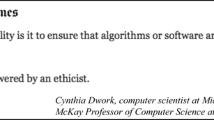Abstract
Opposition to `ownership' of cells and tissues often depends on arguments about the special or sacred nature of human bodies and other living things. Such arguments are not very helpful in dealing with the patenting of DNA fragments. Two arguments undergird support for patenting: the notion that an author has a `right' to an invention resulting from his/her labor, and the utilitarian argument that patents are needed to support medical inventiveness. The labor theory of ownership rights is subject to critique, though it may still have enduring value. The more important argument is that deriving from the common good. If patents on DNA are supported on the basis of their contributions to the common good, then they can also be limited based on considerations of the common good.
Similar content being viewed by others
References
Andrews, L.B. (1986) My Body, My Property. Hastings Center Report (October) 16(5), 28.
Andrews, L.B. and Nelkin D. (2001) Body Bazaar: The Market for Human Tissue in the Biotechnology Age. NY: Crown Publishers.
Annas, G.J. (1990) Outrageous Fortune: Selling Other People's Cells. Hastings Center Report 20(6), 36-39.
Annas, G.J. (1988) Whose Waste Is It Anyway? The Case of John Moore. Hastings Center Report 18(5), 37-39.
Berkeley Organs Watch News (2000) A publication of the Department of Anthropology at the University of California, Berkeley, pp. 10-11.
Brody, B.A. (1999) Protecting Human Dignity and the Patenting of Human Genes. In A.R. Chapman (Ed.), Perspectives on Genetic Patenting: Religion, Science, and Industry in Dialogue. Washington, D.C.: AAAS.
Chapman, A.R. (2000) A Human Rights Perspective on Intellectual Property, Scientific Progress, and Access to the Benefits of Science. (draft)
Chapman, A.R. (1999a) Background and Overview. In A.R. Chapman (Ed.), Perspectives on Genetic Patenting: Religion, Science, and Industry in Dialogue. Washington, D.C.: AAAS.
Chapman, A.R. (1999b) Unprecedented Choices: Religious Ethics at the Frontiers of Genetic Science. Minneapolis: Fortress Press.
Dukepoo, F.C. (1999) Native American Perspectives on Genetic Patenting. In A.R. Chapman (Ed.), Perspectives on Genetic Patenting: Religion, Science, and Industry in Dialogue (pp. 76, 83). Washington, D.C.: AAAS.
Eramian, D. (1999) BIO and the AAAS Genetic Patenting Forum. In A.R. Chapman (Ed.), Perspectives on Genetic Patenting: Religion, Science, and Industry in Dialogue. Washington, D.C.: AAAS.
Evans, J.H. (1999) The Uneven Playing Field of the Dialogue on Patenting. In A.R. Chapman (Ed.), Perspectives on Genetic Patenting: Religion, Science, and Industry in Dialogue. Washington, D.C.: AAAS.
GeneWATCH (1997) 10, Feb.
Gold, E.R. (1996) Body Parts: Property Rights and the Ownership of Human Biological Materials. Washington, D.C.: Georgetown U. Press, Chapter 2.
Goodman, E. (2000) How Can You Patent a Human Gene? Dallas Morning News, March 6.
Haseltine, W. (2000) The Case for Gene Patents. Technology Review (Sept/Oct.), 59.
Hensley, S. (2001) Celera's Human Genetic Code Will be Available on Web Site. Wall Street Journal, Feb 8.
Howard, K. (July 2000) The Bioinformatics Gold Rush. Scientific American 283(1).
Joint Appeal Against Human and Animal Patenting (1995).
Kramer, M.H. (1997) John Locke and the Origins of Private Property: Philosophical Explorations of Individualism, Community, and Equality. Cambridge: Cambridge University Press.
Locke, J. (1962) Second Treatise on Civil Government. In E. Barker (Ed.), Social Contract (Section 28). NY: Oxford U. Press.
Mattei, U. (2000) Basic Principles of Property Law: A Comparative Legal and Economic Introduction. Westport, CT: Greenwood Press.
Mitchell, C.B. (1999) A Southern Baptist Looks at Patenting Life. In A.R. Chapman (Ed.). Perspectives on Genetic Patenting: Religion, Science, and Industry in Dialogue (p. 169). Washington, D.C.: AAAS.
Moltmann-Wendel, E. (1995) I Am My Body: A Theology of Embodiment. NY: Continuum.
Okin, S.M. (1989) Justice, Gender and the Family. NY: Basic Books.
Pateman, C. (1988) The Sexual Contract. Stanford, CA: Stanford University Press.
Pope John XXIII (1961) Mater et Magistra (Christianity and Social Progress) #83. In J. Gremillion (Ed.) (1976), The Gospel of Peace and Justice: Catholic Social Teaching Since Pope John (p. 161). Maryknoll, NY: Orbis Books.
Pope Paul VI (1967) Populorum Progressio (On the Development of Peoples) #22. In J. Gremillion (Ed.) (1976), The Gospel of Peace and Justice: Catholic Social Teaching Since Pope John (p. 394). Maryknoll, NY: Orbis Books.
Pope Pius XI (1931) Quadragesimo Anno (On Social Reconstruction). Boston, MA: Daughters of St. Paul.
Rabinow, P. (1992) Severing the Ties: Fragmentation and Dignity in Late Modernity. Knowledge and Society: The Anthropology of Science and Technology 9, 169-187.
Regalado, A. (2000) The Great Gene Grab. Technology Review (Sept/October), 50.
Sagoff, M. (1998) Patented Genes: An Ethical Appraisal. Issues in Science and Technology Online. Spring National Academy of Sciences. www.nap/issues/14.3/sagoff.htm.
Schleuning, N. (1997) To Have and To Hold: The Meaning of Ownership in the United States. Westport, CT: Praeger.
Second Vatican Council (1965) Gaudium et Spes (Pastoral Constitution on the Church in the Modern World), #71. In J. Gremillion (Ed.) (1976), The Gospel of Peace and Justice: Catholic Social Teaching Since Pope John (p. 307). Maryknoll, NY: Orbis Books.
Shulman, S. (2000) Toward Sharing the Genome. Technology Review (Sept/Oct.), 60.
Vaugh, K.I. (1980) John Locke: Economist and Social Scientist. Chicago: University Chicago Press.
Wright, K. (1998) The Body Bazaar: The Market in Human Organs is Growing. Discover 19:115-120. Reprinted in W. Teays and L. Purdy (Eds.) (2001), Bioethics, Justice and Health Care. Belmont, CA: Wadsworth.
www.med.upenn.edu/-bioethics/whoownslife?
www.nationalacademies.org.




